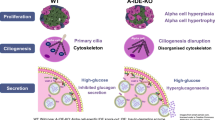Abstract
Intranuclear rodlets (INRs) are structures present within the nuclei of human insulin-secreting beta cells of the endocrine pancreas. Their physiological significance, and whether they are altered in disease, is unknown. In the present study, the proportion of pancreatic beta cells containing INRs was examined in mouse models of type II diabetes and in a model with improved beta cell function. To gain insights into the molecular regulators of INR formation, mice with a conditional adult beta cell-specific knockout of the serine/threonine protein kinase Lkb1 (Lkb1 adult beta cell knockout (LABKO) mice) were studied. To investigate INR changes in a pathophysiological context, beta cell INRs were examined in two models of human metabolic syndrome: (1) mice maintained on a high-fat diet and (2) leptin-deficient ob/ob mice. The proportion of beta cells containing INRs was significantly reduced in LABKO mice. This reduction was not mediated by two key downstream effectors of Lkb1, mTor and Mark2. High-fat diet regimen reduced beta cell INR frequency by more than 40%, and leptin-deficient ob/ob mice exhibited a dramatically (19-fold) reduced INR frequency relative to wild-type mice. Taken together, our results support the view that INR formation in pancreatic beta cells is a dynamic and regulated process. The substantial depletion of beta cell INRs in LABKO and diabetic mice suggests their relationship to beta cell function and potential involvement in diabetes pathogenesis.




Similar content being viewed by others
References
Wajchenberg BL: Beta-cell failure in diabetes and preservation by clinical treatment. Endocr Rev 28:187–218, 2007
Prichett W, Milman P, Gagnon J, Munoz DG, Woulfe J: Intranuclear rodlets in human pancreatic islet cells. Pancreas 35:207–211, 2007
Woulfe J, Munoz D: Tubulin immunoreactive neuronal intranuclear inclusions in the human brain. Neuropathol Appl Neurobiol 26:161–171, 2000
Fu A, Ng AC, Depatie C, Wijesekara N, He Y, Wang GS, Bardeesy N, Scott FW, Touyz RM, Wheeler MB, Screaton RA: Loss of Lkb1 in adult beta cells increases beta cell mass and enhances glucose tolerance in mice. Cell Metab 10:285–295, 2009
Bright NJ, Thornton C, Carling D: The regulation and function of mammalian AMPK-related kinases. Acta Physiol (Oxf) 196:15–26, 2009
Lizcano JM, Goransson O, Toth R, Deak M, Morrice NA, Boudeau J, Hawley SA, Udd L, Makela TP, Hardie DG, Alessi DR: LKB1 is a master kinase that activates 13 kinases of the AMPK subfamily, including MARK/PAR-1. EMBO J 23:833–843, 2004
Granot Z, Swisa A, Magenheim J, Stolovich-Rain M, Fujimoto W, Manduchi E, Miki T, Lennerz JK, Stoeckert CJ, Jr., Meyuhas O, Seino S, Permutt MA, Piwnica-Worms H, Bardeesy N, Dor Y: LKB1 regulates pancreatic beta cell size, polarity, and function. Cell Metab 10:296–308, 2009
Islam MS, Loots du T: Experimental rodent models of type 2 diabetes: a review. Methods Find Exp Clin Pharmacol 31:249–261, 2009
Lindstrom P: The physiology of obese-hyperglycemic mice [ob/ob mice]. ScientificWorldJournal 7:666–685, 2007
Hezel AF, Gurumurthy S, Granot Z, Swisa A, Chu GC, Bailey G, Dor Y, Bardeesy N, Depinho RA: Pancreatic LKB1 deletion leads to acinar polarity defects and cystic neoplasms. Mol Cell Biol 28:2414–2425, 2008
Hurov JB, Huang M, White LS, Lennerz J, Choi CS, Cho YR, Kim HJ, Prior JL, Piwnica-Worms D, Cantley LC, Kim JK, Shulman GI, Piwnica-Worms H: Loss of the Par-1b/MARK2 polarity kinase leads to increased metabolic rate, decreased adiposity, and insulin hypersensitivity in vivo. Proc Natl Acad Sci U S A 104:5680–5685, 2007
Kojima Y, Miyoshi H, Clevers HC, Oshima M, Aoki M, Taketo MM: Suppression of tubulin polymerization by the LKB1-microtubule-associated protein/microtubule affinity-regulating kinase signaling. J Biol Chem 282:23532–23540, 2007
Woulfe JM, Hammond R, Richardson B, Sooriabalan D, Parks W, Rippstein P, Munoz DG: Reduction of neuronal intranuclear rodlets immunoreactive for tubulin and glucocorticoid receptor in Alzheimer’s disease. Brain Pathol 12:300–307, 2002
Muoio DM, Newgard CB: Mechanisms of disease: molecular and metabolic mechanisms of insulin resistance and beta-cell failure in type 2 diabetes. Nat Rev Mol Cell Biol 9:193–205, 2008
Acknowledgments
This study was supported by The Physicians Services Incorporated Foundation 09-01 awarded to JMW and by a CIHR grant to RAS (MOP: 84244). RAS holds the Canada Research Chair in Apoptotic Signaling.
Author information
Authors and Affiliations
Corresponding author
Rights and permissions
About this article
Cite this article
Milman, P., Fu, A., Screaton, R.A. et al. Depletion of Intranuclear Rodlets in Mouse Models of Diabetes. Endocr Pathol 21, 230–235 (2010). https://doi.org/10.1007/s12022-010-9136-5
Published:
Issue Date:
DOI: https://doi.org/10.1007/s12022-010-9136-5




